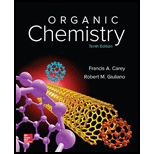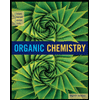
Organic Chemistry - Standalone book
10th Edition
ISBN: 9780073511214
Author: Francis A Carey Dr., Robert M. Giuliano
Publisher: McGraw-Hill Education
expand_more
expand_more
format_list_bulleted
Concept explainers
Textbook Question
Chapter 17.2, Problem 2P
The heats of combustion of 1, 2-epoxybutane (2-ethyloxirane) and tetrahydrofuran have been measured: one is 2499 kJ/mol; the other is 2546 kJ/mol. Match the heats of combustion with the respective compounds.
Expert Solution & Answer
Want to see the full answer?
Check out a sample textbook solution
Students have asked these similar questions
Using the table of bond energies estimate the heat of combustion of one mole of 2,4-dimethyl-1,3-pentadiene.
The molar heat of combustion of gaseous cyclopropaneis -2089 kJ/mol; that for gaseous cyclopentane is-3317 kJ/mol. Calculate the heat of combustion per CH2group in the two cases, and account for the difference.
The molar heat of combustion of gaseous cyclopropane is -2089 kJ/mol; that for gaseous cyclopentane is -3317 kJ/mol. Calculate the heat of combustion per CH2 group in the two cases, and account for the difference.
Chapter 17 Solutions
Organic Chemistry - Standalone book
Ch. 17.1 - Prob. 1PCh. 17.2 - The heats of combustion of 1, 2-epoxybutane...Ch. 17.3 - Prob. 3PCh. 17.4 - Prob. 4PCh. 17.5 - Prob. 5PCh. 17.6 - Problem 17.6 (a) Write equations describing two...Ch. 17.6 - Problem 17.7 Only one combination of alkyl halide...Ch. 17.6 - Prob. 8PCh. 17.8 - Prob. 9PCh. 17.8 - Prob. 10P
Ch. 17.9 - Prob. 11PCh. 17.10 - Problem 17.12 Classify the bromohydrins formed...Ch. 17.11 - Prob. 13PCh. 17.11 - Prob. 14PCh. 17.12 - Prob. 15PCh. 17.12 - Prob. 16PCh. 17.14 - Prob. 17PCh. 17.15 - Prob. 18PCh. 17.16 - Prob. 19PCh. 17.17 - Problem 17.20 There is another oxygen-stabilized...Ch. 17 - Prob. 21PCh. 17 - Many ethers, including diethyl ether, are...Ch. 17 - Although epoxides are always considered to have...Ch. 17 - The name of the parent six-membered...Ch. 17 - Prob. 25PCh. 17 - Prob. 26PCh. 17 - Prob. 27PCh. 17 - Prob. 28PCh. 17 - Prob. 29PCh. 17 - Given that: does the product of the analogous...Ch. 17 - Prob. 31PCh. 17 - Prob. 32PCh. 17 - Prob. 33PCh. 17 - Prob. 34PCh. 17 - Prob. 35PCh. 17 - Prob. 36PCh. 17 - When (R)-(+)-2-phenyl-2-butanol is allowed to...Ch. 17 - Prob. 38PCh. 17 - Prob. 39PCh. 17 - Write a mechanism for the following reaction.Ch. 17 - Prob. 41PCh. 17 - Prob. 42PCh. 17 - Prob. 43PCh. 17 - Prob. 44PCh. 17 - Prob. 45PCh. 17 - Prob. 46DSPCh. 17 - Prob. 47DSPCh. 17 - Prob. 48DSPCh. 17 - Prob. 49DSPCh. 17 - Epoxide Rearrangements and the NIH Shift This...Ch. 17 - Epoxide Rearrangements and the NIH Shift This...
Knowledge Booster
Learn more about
Need a deep-dive on the concept behind this application? Look no further. Learn more about this topic, chemistry and related others by exploring similar questions and additional content below.Similar questions
- Calculate the enthalpy of benzene from its enthalpy of combustion and the enthalpy of combustion of cyclohexanearrow_forwardC2H5OH combustion releases 1200 kJ/mol. How many giving off of C2H5OH is to be burned to generate 6200 kJ energy?arrow_forwardThe heats of combustion (−∆H°) of heptane and 3,3-dimethypentane are 4,817 and 4,809 kJ/mol, respectively. Which statement is true? A. Heptane is 8 kJ/mol more stable then 3,3-dimethylpentane. B. 3,3-Dimethylpentane is 8 kJ/mol more stable than heptane C. Stabilities cannot be compared since they are not isomers. D. Stabilities cannot be compared since they give different combustion products.arrow_forward
- what is the difference between cyclobutanol and cylcobutane when observing their ring strain enthalpies.arrow_forward(a) Calculate the standard enthalpy change for the combustion of 1 mol of benzene, C6H61l2, to CO21g2 and H2O1l2.(b) Compare the quantity of heat produced by combustion of 1.00 g propane with that produced by 1.00 g benzene.arrow_forwardExplain why the bond dissociation enthalpy of a C-H bond in benzene is significantly greater than that in alkanesarrow_forward
- Given that there are three possible cis-dimethylcyclohexanes, if the same amount of these compounds were each combusted in a calorimeter, which one pf the three would be expected to release the least amount of heat?arrow_forwardCarbon–carbon bond dissociation enthalpies have been measured for many alkanes. Identify the alkane in each of the following pairs that has the lower carbon–carbon bond-dissociation enthalpy, and explain the reason for your choice. (a) Ethane or propane (b) Propane or 2-methylpropane (c) 2-Methylpropane or 2,2-dimethylpropane (d) Cyclobutane or cyclopentanearrow_forwardEstimate the heat released when ethene(CH2=CH2) reacts with HBr to giveCH3CH2Br. Bond enthalpies areC-H : 412 kJ/mol; C-C : 348 kJ/mol;C=C : 612 kJ/mol; C-Br : 276 kJ/mol;Br-Br : 193 kJ/mol; H-Br : 366 kJ/mol. Choose the correct answer:1. 1036 kJ/mol2. 58 kJ/mol3. 424 kJ/mol4. 200 kJ/mol5. 470 kJ/molarrow_forward
- Estimate the heat released when 1-butene(CH3CH2CHCH2) reacts with bromine to give CH3CH2CHBrCH2Br. Bond enthalpies are CH : 412 kJ/mol; CC : 348 kJ/mol;CC : 612 kJ/mol; CBr : 276 kJ/mol;BrBr : 193 kJ/mol. 1.317 kJ/mol 2.507 kJ/mol 3.95 kJ/mol 4.288 kJ/mol 5.181 kJ/molarrow_forward1. Write the combustion equations for (a) Complete combustion in theoretical air of 1 mol of gasoline, butane C4 H10 (b) Combustion with 21% excess air (c) Combustion with 9% CO in the product 2. Determine the (d) theoretical air-fuel ratio (e) Actual air-fuel ratioarrow_forwardBased on your observations, compare the stability of organic and inorganic compounds towards heat.arrow_forward
arrow_back_ios
SEE MORE QUESTIONS
arrow_forward_ios
Recommended textbooks for you
 Organic ChemistryChemistryISBN:9781305580350Author:William H. Brown, Brent L. Iverson, Eric Anslyn, Christopher S. FootePublisher:Cengage Learning
Organic ChemistryChemistryISBN:9781305580350Author:William H. Brown, Brent L. Iverson, Eric Anslyn, Christopher S. FootePublisher:Cengage Learning

Organic Chemistry
Chemistry
ISBN:9781305580350
Author:William H. Brown, Brent L. Iverson, Eric Anslyn, Christopher S. Foote
Publisher:Cengage Learning
ENVIRONMENTAL POLLUTION; Author: 7activestudio;https://www.youtube.com/watch?v=oxtMFmDTv3Q;License: Standard YouTube License, CC-BY